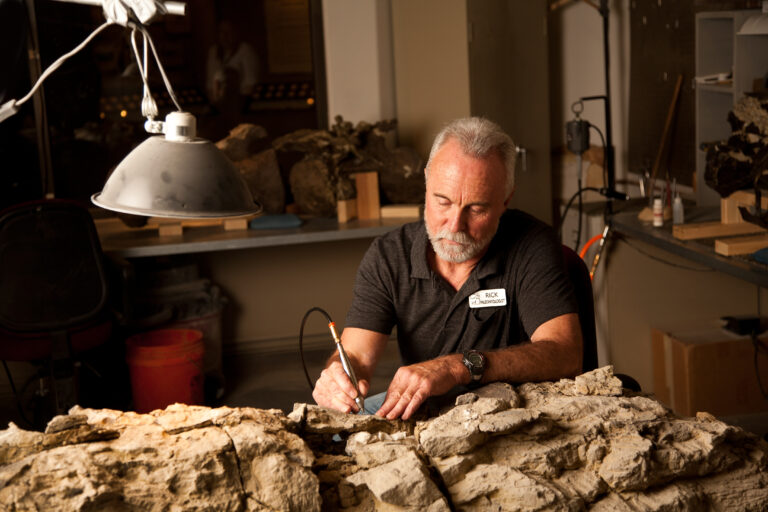In 2020, a new subspecies of Allosaurus was announced – Allosaurus jimmadseni. Named after Utah’s first state paleontologist, James H. Madsen Jr., this new species is older than the more common Allosaurus fragilis. It is older than the more common Allosaurus fragilis. The two species can also be differentiated by a few key cranial features. The first discovery of this new subspecies was found in 1990, but in 2002, Thanksgiving Point Paleontologist Rick Hunter discovered his own juvenile Allosaurus jimmadseni.
In 2002, Rick was working for Western Paleontological Laboratory – a commercial paleontological company that excavates, prepares discoveries, and sells them to museums. Western Paleontological Laboratory is also the company that envisioned and brought the idea of the Museum of Ancient Life to Thanksgiving Point. Rick built exhibits, mounted the casts in the museum, and worked in the paleo lab – that is, when he wasn’t out on a dig. During that time, they were excavating at Bone Cabin Quarry, a dinosaur quarry northwest of Laramie, Wyoming. Bone Cabin Quarry was discovered in the late 1800s and contained species of Stegosaurus, Allosaurus, and Apatosaurus.
Rick worked the standard 9 to 5 at the quarry, but because he is a committed paleontologist at heart, he didn’t stop digging around after the workday ended. He intended to find some ammonites in marine sediments, but he found something much larger instead. After spotting a bone in a low formation, he brought over a few more of his fieldwork friends who helped him dig up a jumble of bones and brought them back to their site. About 60% of the dinosaur was found. They knew it was something different, not the traditional Allosaurus. It was of the new subspecies, first discovered only twelve years earlier, but would not be announced for another 18 years. They prepped the skeleton and then put it up for sale.
In 2022, twenty years after the initial discovery, the real skeleton now rests in Wyoming – the same state where it was discovered. Molds of the original find were made to produce casts for other museums to purchase. His find is, in one way or another, standing in museums all over the world. A cast of Rick’s Allosaurus discovery still stands in the Mountain America Museum of Ancient Life today.
Every year, Rick leaves Thanksgiving Point for a few weeks to continue his fieldwork at Bone Cabin Quarry and hopefully make new discoveries. When he returns in early October, he will continue his work preparing Barry the Barosaurus in the paleo lab. You can see him work his magic when you visit the Mountain America Museum of Ancient Life. You can also see his incredible 2002 Allosaurus find on display.




